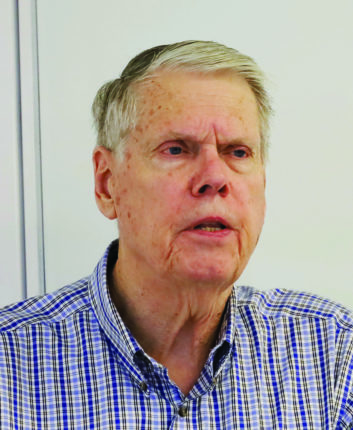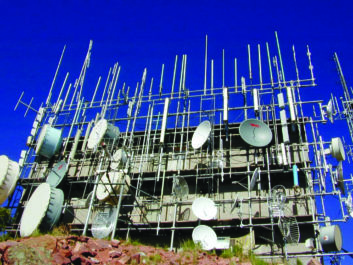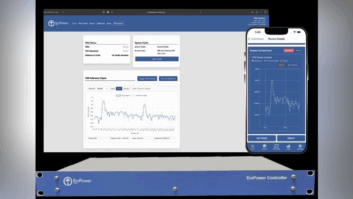
COLUMBIA, Md. — By his own admission, Richard Tell has climbed lots of broadcast towers, gotten himself exposed to some really intense radio frequency fields, suffered RF burns and on occasion has even (accidentally) burned out “some fancy test equipment,” but “never to my knowledge experienced a health effect from my work in RF fields, except for the burns.”
Tell, now 75, and an industry expert in the effects of RF radiation on the human body, shared some of his experiences and deep knowledge of the subject at an RF safety seminar put together by the Washington, D.C., and Baltimore SBE chapters under the auspices of Fred Williard, an officer of the D.C. chapter, and hosted by Rohde & Schwarz at their North American headquarters and training facility.
Tell’s presentation—“Staying Safe in RF Fields”—was tailored to provide broadcast engineering personnel and others involved in RF work with the knowledge they need to stay safe and prevent injury. The free day-long course attracted transmitter operators, station and broadcast group personnel, consulting engineers, network employees, two-way radio service technicians, government and military employees, amateur radio operators and even a SiriusXM satellite radio representative from as far away as New York and Richmond, Va.

Tell, an IEEE Life Fellow and chair of RF safety-related committees within IEEE, spent some 20 years with the federal government, working for the Center for Devices and Radiological Health, and later serving as chief of U.S. Environmental Protection Agency’s Electromagnetics Branch, and providing technical support to the FCC when that agency was setting new rules for human exposure to RF fields.
His 52-year-long career not only includes laboratory work and computer modeling, but also plenty of “hands-on” experience—including purposefully subjecting himself to RF currents—that makes him uniquely qualified to impart knowledge and field inquiries into this sometimes rather gray area of radio and TV station operations.
WHERE THE DANGER LIES
In setting the stage for the “practical” portion of his presentation, Tell provided a definition of “MPE,” or Maximum Permissible Exposure (“according to the FCC, this is the amount of field exposure outside the body that is considered safe”), and “SAR,” or Specific Absorption Rate (“the rate at which RF is absorbed in the body, and which is the basis for our safety standards”).
He also distinguished between ionizing and non-ionizing radiation—terms that confuse many lay people and even some professionals. Ionizing radiation occurs when there’s sufficient energy to remove electrons from an atom typically associated with very penetrating radiations, such as x-ray and gamma; non-ionizing refers to any other type of electromagnetic radiation, including the radio frequency spectrum.
“Radio waves do not have sufficient energy to ionize atoms,” said Tell, assuring course attendees that this was not something they had to worry about. “RF fields are not the same as ionizing radiation. They cannot ionize tissue, and unlike ionizing radiation, the biological effects are not cumulative.”
Tell explained that aside from burns suffered from contacting RF-energized conductors, the greatest effect of radio waves on living organisms was heating of tissues, noting that 60 years of research on the effects of RF exposure has established, among other things, that when RF levels fall below a certain threshold, there is no measurable effect on human bodies. Such research has also established a useful “threshold” for what constitutes an excessive RF level.
“The most sensitive and reliable indicator of an established and potentially adverse biological effect of RF radiation exposure has been behavioral disruption of a learned task in laboratory animals,” said Tell. “Their performance ‘slacks off’ because they are ‘warming up’ and less inclined to do what they were trained to do.”
[Strickland Taught the Industry About RF Safety]
He noted that the threshold for such behavior modification began at a SAR of about 4W per kilogram of body weight, and that this exposure level had been extrapolated to humans and adopted by the FCC in its regulations limiting exposure. Tell stated that a safety factor of 10 is used to constitute what is considered “safe,” with 50 times less exposure being “safer than safe.”
Tell said that in calculating what a “0.4W/kg safe” exposure would be for a 180-pound individual, it amounts to 33W distributed within the tissues. He noted that the normal metabolic rate for humans at rest is about 105W.

“When RF energy is delivered to a lossy material such as body tissue, it produces heating of those tissues,” he said. “Elimination of heating of the body is the primary objective of most safety regulations today.”
Tell observed that the effects of RF on the body are not uniform, with some areas being heated more than others, and that this heating is frequency-dependent, as humans resonate at around 65 MHz.
About 40 people from radio and television operations, government agencies, consulting firms, and other enterprises working in RF attended the day-long seminar.
About 40 people from radio and television operations, government agencies, consulting firms, and other enterprises working in RF attended the day-long seminar.
“FCC exposure limits are based on limiting the rate at which RF energy is absorbed in terms of watts per kilogram of body mass so that you don’t warm up,” said Tell. “A hazardous level of exposure is reached when you begin to warm up from the RF energy impinging on your body.
“The ‘take-home’ here is that if you feel warmer than you suspect would be normal, back off and ensure that your exposure is within the accepted limits.”
PROTECTIVE MEASURES
Tell noted that portable “clip-on” RF monitors, while not necessarily precise indicators, do provide “early warning” information that is useful in flagging what may lead to excessive exposure in RF environments. He also provided some tips for proper use of such monitoring devices, as well as suggestions for mitigating one’s exposure.
 “Always wear an RF monitor on the front of your shirt; it should face the antennas generating the radiation you’ll be exposed to,” said Tell. “The difference between front and back can amount to a factor of 16 at 100 MHz. If the monitor sounds only occasionally that’s not a problem. If it’s steady, then it’s time to get out of the area.
“Always wear an RF monitor on the front of your shirt; it should face the antennas generating the radiation you’ll be exposed to,” said Tell. “The difference between front and back can amount to a factor of 16 at 100 MHz. If the monitor sounds only occasionally that’s not a problem. If it’s steady, then it’s time to get out of the area.
“If you have to work close to a high-power antenna, use a personal monitor to determine if the area is below the exposure level; if not, the transmitter must be shut down and locked/tagged out, especially if it’s remotely operated. Take the lockout key with you until all work is completed and the system can be returned to normal operation.”
Other tips include staying behind directional antennas when doing tower work and exercising care when working around non-directional radiators.
“You cannot hide behind an omnidirectional antenna like you can a dish, a Yagi or a panel antenna,” Tell said.
He observed that there were some cases where broadcast operations could not be interrupted and doing work around such transmission sites called for operating with reduced power or wearing a protective body suit and hood designed to attenuate RF exposure to the body.
“Such a suit greatly reduces RF exposure,” said Tell. “But always remember that the suit does not make you into Superman.”







